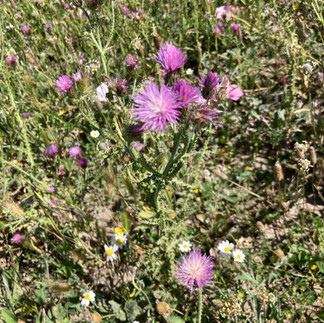April: a key month where the future of the olive grove is defined
- maellesoreau2006
- May 20
- 3 min read
Olive tree flowering is a key moment that determines future yield. In 2024 and 2025, timely rains and mild temperatures have supported strong floral development. However, flower fertility and protection from pests remain essential. Phytosanitary treatments should be applied before flowering to avoid interfering with pollination. All signs point to a promising harvest, though continued attention is crucial.
With the arrival of April, the olive grove enters a decisive stage: it is the moment when what will be the future harvest begins to be defined. At this point of the year, the shoots that have been developing begin to show their true vocation: to become leaves or flowers. That bifurcation is what will mark the productive potential of each tree, since only from the buds that are transformed into inflorescences can we aspire to fruit.
Inflorescences: thermometer of the next production
To evaluate this first approximation to the yield of the olive grove, it is essential to observe in the field the average number of inflorescences per shoot. This data not only gives us a quantitative idea about the potential volume of flowering, but also allows us to compare with previous campaigns, establishing trends and anticipating results.
Each bud can generate an inflorescence or simply new leaves. When the yolk evolves towards floral formation, a process begins that, with successful pollination, can culminate in fruit. Therefore, a higher proportion of inflorescences with respect to leaves indicates a greater productive vocation of the olive grove.
Floral fertility: quality before quantity
However, it is not enough to count flowers: the key is their fertility. An inflorescence can have many flowers, but if they are not fertile, the curdle rate will be very low. Therefore, it is essential to carry out a sampling when the flower buds are sufficiently developed, analysing what percentage of them have adequate fertility. A fertile flower is capable of becoming a fruit; a sterile one is not.
As a rule of thumb, in the warmer and lower altitude areas, some plants are already beginning to show the first signs of open flowering, or are a few days away from doing so. On the other hand, in colder and higher areas, flowering could be delayed for another two or three weeks.
Salvating rains: water at the right time
In 2025, the rains have arrived at a decisive moment. Unlike last year - in which April was dry and abnormally warm - recent rainfall has significantly improved the water status of the soil, contributing to the healthy development of shoots and inflorescences.
The lack of water in this critical phase can slow down floral development, since the plant needs moisture to mobilise the nutrients that feed its growth. Without water, the flower weakens, and if high temperatures are also added, the damage can be irreversible: dehydration, malformations and massive loss of flowers.
Remember that flowering is a short-term event, which in each area can span between 7 and 10 days. During that period, everything must work properly so that an optimal curdle is achieved. It is, therefore, a short but absolutely decisive phase.
Phytosanitary treatments: anticipate, do not interfere
April is also the ideal month to adjust the last foliar treatments before flowering. Once the olive tree enters this reproductive phase, it is recommended to avoid any application that may interfere with the natural process of flowering and fertilisation.
Preventive treatments should be applied well in advance, allowing the olive tree to face flowering without chemical obstacles that may affect fertility or the attraction of pollinators. A good synchronisation in this sense can make the difference in final productivity.
Pests under surveillance: the prays and its floral threat
With regard to pests, April is especially delicate due to the appearance of the second generation of prays oleae, known as the anthophagous generation. This small moth can directly affect the flowers, perforating them and reducing the number of flowers useful for curdling.
If flowering is abundant, this pest can go unnoticed. However, in those olive groves with few inflorescences, the damage can be significant. Therefore, continuous follow-up and monitoring is essential to decide whether to intervene or not, avoiding unnecessary treatments if the conditions are favourable.
Positive outlook in 2025
Fortunately, everything seems to indicate that this year the conditions are accompanying. The combination of rains on time, mild temperatures and a promising floral development augurs a more hopeful campaign than the previous one. Even so, it is essential to remain attentive, since the margin of error at this stage is minimal.
























Comments